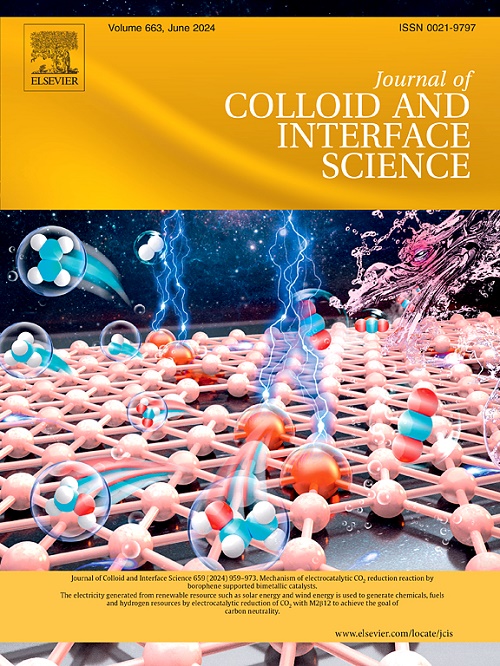Raspberry-like gold nano-conjugates of block copolymer prodrug based bicontinuous nanoparticles for cancer theranostics
IF 9.4
1区 化学
Q1 CHEMISTRY, PHYSICAL
引用次数: 0
Abstract
Theranostic nanoparticles like polymer conjugated gold nanoparticles are at the cutting edge of cancer therapy, offering an integrated platform for simultaneous diagnosis and treatment. In this study, we report a nanoconjugate (P2AuNPs) by combining doxorubicin (DOX) tethered polymeric prodrug based bicontinuous nanoparticles (P2NPs), developed recently by us, with gold nanoparticles (AuNPs). The AuNPs were generated by in situ reduction of HAuCl4, where different polymer functionalities served the role of reducing and stabilizing agents. The bicontinuous morphology of P2NPs provided a unique template for the growth of gold nanoparticles, resulting in an overall raspberry-like morphology. Compared to existing small-sized theranostic AuNPs, which often trigger systematic cytotoxicity, the synthesized P2AuNPs had an ideal size of ∼90 nm for passive targeting of cancer cells through leaky tumor blood vessels. Furthermore, the embedded gold nanoparticles in P2AuNPs nanoconjugate served as a nanometal surface energy transfer (NSET) pair with the covalently attached DOX molecules, resulting in the significant quenching of DOX (turned ‘OFF’ state) fluorescence at physiological pH (7.4) as confirmed through steady-state and time-resolved fluorescence measurements. It was also possible to recover the quenched DOX fluorescence (turned ‘ON’ state) with the release of DOX selectively in cancer cell lines, plausibly due to higher glutathione (GSH) levels and acidic pH. In vitro cellular studies asserted the safe nature of P2NPs against non-cancerous cells (HEK-293T) while exhibiting significantly higher drug-induced cytotoxicity against cancerous cells (MCF-7) compared to free DOX. Moreover, when P2AuNPs were incubated with HEK-293T and MCF-7 cells, a fluorescence turn ‘ON’ for DOX was observed only in MCF-7 cells after the release of DOX, thereby providing an opportunity to improve the sensitivity of imaging and real-time monitoring of drug release. Together, this integrated theranostic system not only has the potential to enhance the precision and effectiveness of cancer therapy but also offers improved monitoring capabilities, representing a significant advancement in tailored nanomedicine.

基于嵌段共聚物原药的树莓状金纳米共轭物双连续纳米粒子用于癌症疗法
聚合物共轭金纳米粒子等抗癌纳米粒子是癌症治疗的前沿技术,为同时进行诊断和治疗提供了一个综合平台。在这项研究中,我们报告了一种纳米共轭物(P2AuNPs),它是由我们最近开发的基于多柔比星(DOX)系留聚合物原药的双连续纳米粒子(P2NPs)与金纳米粒子(AuNPs)结合而成。AuNPs 是通过原位还原 HAuCl4 生成的,其中不同的聚合物官能团起到了还原剂和稳定剂的作用。P2NPs 的双连续形态为金纳米粒子的生长提供了独特的模板,从而形成了树莓状的整体形态。现有的小尺寸治疗用金纳米粒子通常会引发系统性细胞毒性,与之相比,合成的 P2AuNPs 具有 90 纳米的理想尺寸,可通过肿瘤渗漏血管被动靶向癌细胞。此外,通过稳态和时间分辨荧光测量证实,P2AuNPs 纳米共轭物中嵌入的金纳米粒子与共价连接的 DOX 分子形成了纳米表面能量转移(NSET)对,从而在生理 pH 值(7.4)下显著淬灭 DOX("关 "态)荧光。由于谷胱甘肽(GSH)水平较高和 pH 值呈酸性,在癌细胞系中,随着 DOX 的选择性释放,淬灭的 DOX 荧光("开启 "状态)也有可能恢复。体外细胞研究表明,P2NPs 对非癌细胞(HEK-293T)是安全的,而对癌细胞(MCF-7)的药物诱导细胞毒性则明显高于游离 DOX。此外,当 P2AuNPs 与 HEK-293T 和 MCF-7 细胞孵育时,只有在释放 DOX 后的 MCF-7 细胞中才能观察到 DOX 的荧光 "ON",从而为提高成像灵敏度和实时监测药物释放提供了机会。总之,这种集成治疗系统不仅有可能提高癌症治疗的精确性和有效性,还能提供更好的监测能力,是定制纳米医学的一大进步。
本文章由计算机程序翻译,如有差异,请以英文原文为准。
求助全文
约1分钟内获得全文
求助全文
来源期刊
CiteScore
16.10
自引率
7.10%
发文量
2568
审稿时长
2 months
期刊介绍:
The Journal of Colloid and Interface Science publishes original research findings on the fundamental principles of colloid and interface science, as well as innovative applications in various fields. The criteria for publication include impact, quality, novelty, and originality.
Emphasis:
The journal emphasizes fundamental scientific innovation within the following categories:
A.Colloidal Materials and Nanomaterials
B.Soft Colloidal and Self-Assembly Systems
C.Adsorption, Catalysis, and Electrochemistry
D.Interfacial Processes, Capillarity, and Wetting
E.Biomaterials and Nanomedicine
F.Energy Conversion and Storage, and Environmental Technologies

 求助内容:
求助内容: 应助结果提醒方式:
应助结果提醒方式:


